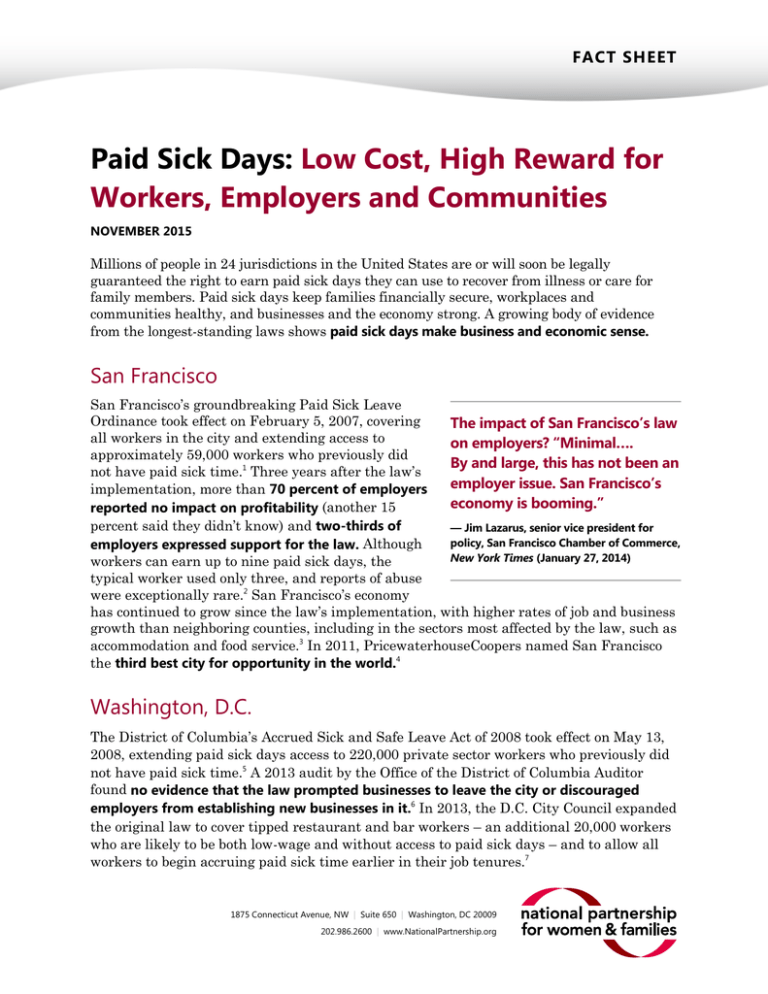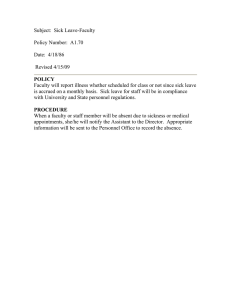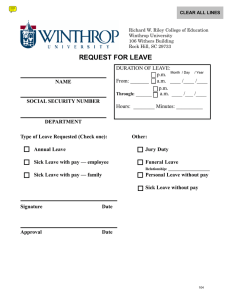
FACT SHEET
Paid Sick Days: Low Cost, High Reward for
Workers, Employers and Communities
NOVEMBER 2015
Millions of people in 24 jurisdictions in the United States are or will soon be legally
guaranteed the right to earn paid sick days they can use to recover from illness or care for
family members. Paid sick days keep families financially secure, workplaces and
communities healthy, and businesses and the economy strong. A growing body of evidence
from the longest-standing laws shows paid sick days make business and economic sense.
San Francisco
San Francisco’s groundbreaking Paid Sick Leave
Ordinance took effect on February 5, 2007, covering
The impact of San Francisco’s law
all workers in the city and extending access to
on employers? “Minimal….
approximately 59,000 workers who previously did
By and large, this has not been an
not have paid sick time.1 Three years after the law’s
employer issue. San Francisco’s
implementation, more than 70 percent of employers
economy is booming.”
reported no impact on profitability (another 15
percent said they didn’t know) and two-thirds of
— Jim Lazarus, senior vice president for
policy, San Francisco Chamber of Commerce,
employers expressed support for the law. Although
New York Times (January 27, 2014)
workers can earn up to nine paid sick days, the
typical worker used only three, and reports of abuse
were exceptionally rare.2 San Francisco’s economy
has continued to grow since the law’s implementation, with higher rates of job and business
growth than neighboring counties, including in the sectors most affected by the law, such as
accommodation and food service.3 In 2011, PricewaterhouseCoopers named San Francisco
the third best city for opportunity in the world.4
Washington, D.C.
The District of Columbia’s Accrued Sick and Safe Leave Act of 2008 took effect on May 13,
2008, extending paid sick days access to 220,000 private sector workers who previously did
not have paid sick time.5 A 2013 audit by the Office of the District of Columbia Auditor
found no evidence that the law prompted businesses to leave the city or discouraged
employers from establishing new businesses in it.6 In 2013, the D.C. City Council expanded
the original law to cover tipped restaurant and bar workers – an additional 20,000 workers
who are likely to be both low-wage and without access to paid sick days – and to allow all
workers to begin accruing paid sick time earlier in their job tenures.7
1875 Connecticut Avenue, NW | Suite 650 | Washington, DC 20009
202.986.2600 | www.NationalPartnership.org
Connecticut
Connecticut was the first state to enact a paid sick days law. It took effect on January 1,
2012, extending paid sick days access to approximately 200,000 workers who previously did
not have paid sick time,8 particularly those with the highest rates of contact with the public
but lowest rates of access to paid sick time.9 A survey of employers found that the law has
had a minimal impact on costs, and few employers have made adjustments such as
increasing prices or reducing employee hours because of it. Employers identified several
positive effects of paid sick days, including improved employee productivity and morale,
and more than three-quarters expressed support for the law.10 Further, data from the
state’s Department of Labor show job growth across industries since the law’s
implementation, including in the most affected industry – leisure and hospitality.11
Seattle
Seattle’s Paid Sick and Safe Time Ordinance took effect on September 1, 2012, covering
nearly all workers in the city and extending coverage to approximately 150,000 workers
who previously did not have access to paid sick time.12 Research prepared for the Office of
the City Auditor by the University of Washington found that the number of firms, the
number of Seattle employees, and total wages in the city increased, and employer growth
was significantly stronger in Seattle than in Bellevue, Everett and Tacoma combined in the
year following the ordinance’s implementation, controlling for factors such as seasonal
variation. Nearly 70 percent of employers say they experienced no administrative
difficulties with implementation and 70 percent of employers say they support the law.13
And a small business association study released a year after the law was implemented
found no evidence that the law had a negative impact on the economy.14
Jersey City
The Jersey City Earned Sick Time Ordinance took effect on January 24, 2014, covering
nearly 40,000 workers who previously did not have paid sick time.15 A report issued by
Rutgers’ Center for Women and Work found that one year after the law took effect, 80
percent of businesses were providing earned sick days and 62 percent of businesses did
not need to change their policies to adhere to the law. Businesses that did change their
policies reported significant benefits, including a reduction in the number of sick
employees coming to work, an increase in productivity, an improvement in the quality of
new hires and a reduction in employee turnover.16 Jersey City is now one of nine New
Jersey cities that have adopted paid sick days laws. Newark’s law took effect in 2014. The
others have taken or will take effect in 2015.
New York City
New York City’s Earned Sick Time Act took effect on April 1, 2014, covering approximately
1,200,000 workers who previously did not have paid sick time.17 A report from the New
York Department of Consumer Affairs (DCA) found that New York City’s economy thrived
NATIONAL PARTNERSHIP FOR WOMEN & FAMILIES | FACT SHEET | PAID SICK DAYS: LOW COST, HIGH REWARD
2
in the first year since the law’s implementation. The number of businesses in the city grew
and consumer prices fell. New York City’s unemployment rate was the lowest it had been
in six years, labor force participation was the highest on record and private sector
employment grew 3.3 percent, adding 112,300 jobs. Job growth in the industries that
historically did not provide paid sick time – arts, entertainment and recreation, retail
trade, accommodation and food services, construction and administration, support and
waste services – also remained strong, rising an average of 3.1 percent.18
More Positive Evidence on the Horizon
Four states, the District of Columbia and 19 localities have or will soon have paid sick days
laws in place.19 These and future laws will add to the growing body of evidence showing that
paid sick days are good for all – and that a national standard is needed.
1 Drago R., & Lovell, S. (2011, April). San Francisco’s Paid Sick Leave Ordinance: Outcomes for Employers and Employees. Institute for Women’s Policy Research Publication. Retrieved
17 April 2015, from http://www.iwpr.org/publications/pubs/San-Fran-PSD (based on median number of days taken by employees in San Francisco)
2 Ibid.
3 Miller, K., & Towne, S. (2011, September). San Francisco Employment Growth Remains Stronger with Paid Sick Days Law Than Surrounding Counties. Institute for Women’s Policy
Research Publication. Retrieved 12 February 2015, from http://www.iwpr.org/publications/pubs/san-francisco-employment-growth-remains-stronger-with-paid-sick-days-law-thansurrounding-counties
4 PricewaterhouseCoopers & Partnership for New York City. (2011). Cities of Opportunity. Retrieved 17 April 2015, from http://www.pwc.com/us/en/cities-ofopportunity/2011/pdfdownload.jhtml
5 Williams, C., & Hayes, J. (2013, October). Valuing Good Health in the District of Columbia: The Costs and Benefits of the Earned Sick and Safe Leave Amendment Act of 2013. Institute
for Women’s Policy Research Publication; Williams, C. (2013, November 21). Personal communication. (Research Analyst, Institute for Women’s Policy Research).
6 Branche, Y. (2013, June). Audit of the Accrued Sick and Safe Leave Act of 2008. Office of the District of Columbia Auditor. Retrieved 17 April 2015, from
http://dcauditor.org/sites/default/files/DCA092013.pdf
7 Williams, C., & Hayes, J. (2013, October). Valuing Good Health in the District of Columbia: The Costs and Benefits of the Earned Sick and Safe Leave Amendment Act of 2013. Institute
for Women’s Policy Research Publication. Retrieved 17 April 2015, from http://www.iwpr.org/publications/pubs/valuing-good-health-in-the-district-of-columbia-the-costs-andbenefits-of-the-earned-sick-and-safe-leave-amendment-act-of-2013
8 Farrell, L. (2013, May). Personal communication. (Executive Director, Connecticut Working Families).
9 Williams, C. & Gault, B. (2014, March). Paid Sick Days Access in the U.S.: Differences by Race/Ethnicity, Occupation, Earnings, and Work Schedule. Institute for Women’s Policy
Research Publication. Retrieved 23 February 2015, from http://www.iwpr.org/publications/pubs/paid-sick-days-access-in-the-united-states-differences-by-race-ethnicityoccupation-earnings-and-work-schedule
10 Appelbaum, E., & Milkman, R. (2014, January). Good for Business? The Case of Paid Sick Leave in Connecticut. Center for Economic and Policy Research Publication. Retrieved 17
April 2015, from http://www.cepr.net/index.php/blogs/cepr-blog/is-paid-sick-leave-good-for-business
11 Office of Research, Connecticut Department of Labor. (2015, January). Nonfarm Employment/Residents Employed - State of Connecticut, Labor Market Information. Retrieved 17
April 2015, from http://www1.ctdol.state.ct.us/lmi/ctnonfarmemployment.asp; Office of Research, Connecticut Department of Labor. (2015, January). Leisure and Hospitality Sector State of Connecticut, Labor Market Information. Retrieved 17 April 2015, from http://www1.ctdol.state.ct.us/lmi/sectors/leisure.asp
12 Go Hollo, T. (2013, March 19). Personal communication. (Policy Associate, Economic Opportunity Institute).
13 Romich, J., et al. (2014, April 23). Implementation and Early Outcomes of the City of Seattle Paid Sick and Safe Time Ordinance. University of Washington Publication. Retrieved 17
April 2015, from http://www.seattlemet.com/data/files/2014/4/attachment/194/PSSTO_UWReport_wAppendices_copy.pdf
14 The Main Street Alliance of Washington. (2013, September). Paid Sick Days and the Seattle Economy: Job growth and business formation at the 1-year anniversary of Seattle’s Paid
Sick and Safe Leave law. Retrieved 17 April 2015, from http://washington.mainstreetalliance.org/files/2013/09/PSD-1-Year-Report-Final.pdf
15 Williams, C. (2013, December). Personal communication. (Research Analyst, Institute for Women’s Policy Research).
16 Lindemann, D., & Britton, D. (2015, April). Earned Sick Days in Jersey City: A study of employers and employees at Year One. Center for Women and Work at Rutgers, the State
University of New Jersey Publication. Retrieved 17 April 2015, from,
http://cww.rutgers.edu/sites/cww.rutgers.edu/files/documents/working_families/Jersey_City_ESD_Issue_Brief.pdf
17 New York City Consumer Affairs. (2015). NYC’s Paid Sick Leave Law: First Year Milestones. Retrieved 27 October 2015, from
http://www1.nyc.gov/assets/dca/downloads/pdf/about/PaidSickLeaveLaw-FirstYearMilestones.pdf
18 Ibid.
19 National Partnership for Women & Families. (2015). Current Paid Sick Days Laws. Retrieved 29 October 2015, from http://www.nationalpartnership.org/research-library/workfamily/psd/current-paid-sick-days-laws.pdf
The National Partnership for Women & Families is a nonprofit, nonpartisan advocacy group dedicated to promoting fairness in the workplace, access to quality health care and
policies that help women and men meet the dual demands of work and family. More information is available at NationalPartnership.org.
© 2015 National Partnership for Women & Families. All rights reserved.
NATIONAL PARTNERSHIP FOR WOMEN & FAMILIES | FACT SHEET | PAID SICK DAYS: LOW COST, HIGH REWARD
3



